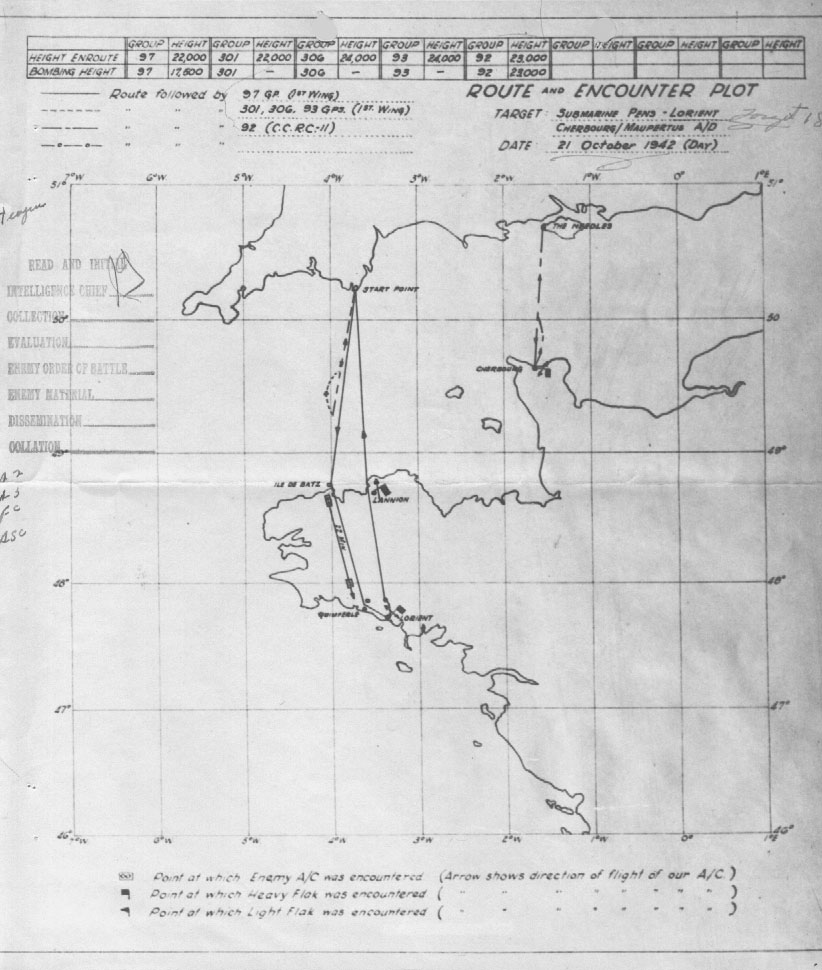Copy No. 69 |
||
HEADQUARTERS VIII BOMBER COMMAND |
||
E.T.O. |
||
| ORS Day Raid Report | ||
| No. 14 | ||
December 30, 1942. |
||
OCTOBER 21, 1942 OPERATIONS |
||
INTRODUCTORY STATEMENT |
||
| On October 21, 1942 operations were conducted against (1) the submarine base at Lorient, and (2) the Cherbourg-Maupertus Airdrome, this later operation being conducted as a diversion to the Lorient operation. | ||
| 1. Twenty-four B-24s from 93rd Group and 66 B-17s from the 97th, 301st and 306th Groups were dispatched to attack the U-boat base at Lorient. | ||
| Of the 90 bombers dispatched, 15 B-17s from the 97th Group reached the target area dropping 60,000 lbs. H.E. bombs over or in the vicinity of the target area, and the balance were abortive. | ||
| Five B-17s were damaged by enemy aircraft or flak, and 3 were lost (97th) | ||
| Thirty crew members are either missing or prisoners of war, one was seriously wounded and four were slightly wounded. | ||
| The 97th Group claimed ten enemy aircraft destroyed, four probably destroyed and three damaged. | ||
| 2. Seventeen B-17s from 92nd Group were dispatched to conduct a diversionary raid on the Cherbourg-Maupertus Airdrome. | ||
| Eight of the B-17s dropped 16,000 lbs. H.E. Bombs on or in the vicinity of the target area. | ||
| None of the B-17s were lost or damaged and none of our personnel was lost or wounded. | ||
| There were no encounters with enemy aircraft. | ||
| * All figures in this report as to bombs dropped "Over or In the Vicinity of the Target Area" are based on claims of crews as to the disposition made of the bombs carried, and do not purport to represent in any sense a measure of the bombing accuracy or of the damage inflicted. | ||
- 1 - |
||
DETAILS OF OPERATIONS AGAINST LORIENT SUBMARINE BASE |
||
| 1. Target Objective: | ||
| (a) Primary Target: The primary target was the Submarine Pens at Lorient/Keroman. The pens have been constructed in three blocks, the Northern of 7 pens 400' x 50' each, and the Southern of 7 pens 541' x 475' (overall dimension) on the land west of the Long Basin. The blocks are made of reinforced concrete with roofs approximately 11 1/2 ft. thick, and outside walls of about 8 ft. 3 ins. thickness. The pens will accommodate about 23 U-boats. | ||
| (b) Secondary Target: The secondary target, which was not attacked, was the submarine base at Brest. | ||
| (c) Last Resort Target: The last resort target, which also was not attacked, was vessels in several areas in the port of St. Malo. | ||
| 2. Combat Order. | ||
| Combat order No, 36, dated October 20, 1942, from the Commanding General VIII Bomber Command to the Commanding Officers of the first Bomb Wing, 11th Combat Crew Replacement Center, VIII Fighter Command and 10 (Fighter) Group RAF, was divided into two parts. The first part related to the diversionary operation and the second to the raid on Lorient. The second part specified the targets heretofore mentioned and ordered a raid on October 21, 1942, by (1) 24 B-24s from 93rd Group (2) 24 B-17s from 97th Group (3) 24 B-17s from 301st Group and (4) 18 B-17s from 306th Group. The bombing times were (1) 93rd Group - 1254; (2) 301st Group - 1317; (3) 306th Group - 1327. No time was mentioned for the 97th Group; from Start Point to Isle de Groix and thence to target. | ||
| Specified Route to and from Target: All Groups from their home bases remaining below 10,000 ft. to 10 miles south of Bath, continuing on course to Start Point at the following times and altitudes (1) 93rd Group 17,000 ft. 1200 hours (2) 301st Group 18,000 ft. 1205 hours (3) 306th Group 19,000 ft. 1210 hours, from that Point to Isle de Groix and thence to target. After bombing turn left proceeding to home base via 5 miles west of Lannien, maintaining bombing altitudes until half way across the Channel. | ||
- 2 - |
||
